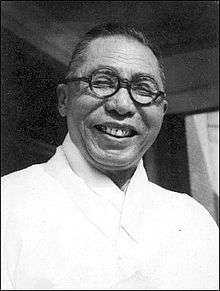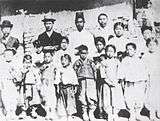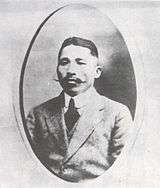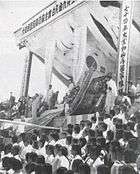Kim Koo
| Kim Koo 김구 金九 | |
|---|---|
 | |
| 6th President of the Provisional Government of the Republic of Korea | |
|
In office 1927–1927 | |
| Vice President | Kim Kyu-sik |
| Preceded by | Hong Jin |
| Succeeded by | Yi Dong-nyung |
| 12th, 13th President of the Provisional Government of the Republic of Korea | |
|
In office 1939 – August 15, 1948 | |
| Preceded by | Yi Dong-nyung |
| Succeeded by |
Rhee Syngman (President of the Provisional Government) |
| Personal details | |
| Born |
August 29, 1876 Baegun-dong, Haeju, Hwanghae, Joseon Dynasty |
| Died |
June 26, 1949 (aged 72) Seoul, South Korea |
| Nationality | Korean |
| Political party | Korean Independence Party |
| Kim Koo | |
| Hangul | 김구 |
|---|---|
| Hanja | 金九 |
| Revised Romanization | Gim Gu |
| McCune–Reischauer | Kim Ku |
| Pen name | |
| Hangul | 백범 or 연상 |
| Hanja | 白凡 or 蓮上 |
| Revised Romanization | Baekbeom or Yeonsang |
| McCune–Reischauer | Paekpŏm or Yŏnsang |
| Courtesy name | |
| Hangul | 연하 |
| Hanja | 蓮下 |
| Revised Romanization | Yeonha |
| McCune–Reischauer | Yŏnha |
Kim Koo (김구; 金九; Kim Gu or Kim Ku Korean pronunciation: [kimɡu]; also known by his pen name Baekbeom (백범; 白凡; [pɛkpʌm]), August 29, 1876 – June 26, 1949) was a Korean nationalist politician. He was the sixth and later the last Premier of the Provisional Government of the Republic of Korea, a leader of the Korean independence movement against the Japanese Empire,[note 1][note 2][note 3][note 4] and a reunification activist after 1945.
Biography
Early life
Kim was born on August 29 (11th day of the 7th month in the Lunar Calendar), 1876 in Teot-gol (텃골), Baek-un-bang (백운방), Haeju (해주; 海州), South Hwanghae Province, Korea, the only son of a farmer Kim Soon-young (김순영) and his wife Kwak Nack-won (곽낙원). His name at birth was Kim Changahm (김창암; 金昌巖; [kimtɕʰaŋam]). When he was nine years old, he started to study Chinese classic texts such as Zizhi Tongjian (자치통감; 資治通鑒), and Great Learning (대학; 大學) at local seodangs.
Leader of Donghak movement
At the age of 16, Kim applied for the Gwageo (Imperial Examination) of Joseon but failed. After that, he joined the Donghak Movement (동학; 東學), a rebellion against government and foreign oppressions in 1893 and changed his name to Kim Changsoo (김창수; 金昌洙). As the organization grew rapidly, he was appointed the district leader of Palbong (팔봉) at the age of 17 and a Donghak army regiment. Under the instruction of Donghak leader Choi Si-hyung (최시형; 崔時亨), Kim's troops stormed the Haeju fort in Hwanghae-do, but the army was eventually defeated by governmental forces. After that, he was defeated by his companion, Lee Dong-yeop (이동엽) in the turf war of Donghak’s organization. Thereafter, the Royal Army's General An Tae-hun (안태훈; 安泰勳; (father of Ahn Jung-geun (안중근; 安重根) who would in 1909 assassinate the Japanese governor Ito Hirobumi (伊藤博文)), gave Kim's Donghak rebels a safe pass, but other government troops ignored An's safe pass and attacked them. At 20, with I-eon Kim whom he had met around Yalu River, Kim attacked the Royal Army unit holding the Gang-gye fort, supported by the Qing Dynasty's army. However, the attack failed and he went into hiding.
Assassination of Josuke Tsuchida
In February 1896, Kim stayed at an inn in Chihapo, Hwanghae Province while traveling to southern regions. There he found a Japanese man named Tsuchida Josuke (土田譲亮), who was a trader from Tsushima, Nagasaki, Japan, and killed him believing that he was a Japanese army lieutenant involved in the assassination of the queen.[note 5] [note 6] [note 7]
In his autobiography, 'Baekbeom Ilji' (백범일지, 白凡逸志, Baekbeom Journal), Kim describes his motivation at the time as follows:
Since many Japaneses go through Chihapo every day, there is no reason for him to disguise as a Korean if he were an ordinary merchant or workman. Could he be Miura or one of his accomplices who killed the queen, fled from Seoul and hiding here? Even if he is not, a Japanese man with a disguise and a sword can do nothing but harm to my country and people. I will revenge for my queen by killing this Japanese man.— Baekbeom Ilji
The following morning, Kim attacked Tsuchida, and killed him. The "Report from acting administrator Hagihara Moriichi of Incheon Consulate on the current situation of Incheon" describes Tsuchida as a "commoner from Nagasaki Prefecture" and an "employee of a Nagasaki trader on a business trip".[1]
However, Kim argued in his autobiography that Tsuchida was concealing a sword and had identification papers that showed him to be a Japanese army lieutenant.[2]
Jailbreak, and educational activities

Kim was tortured and sentenced to death. According to 'Baekbeom Ilji', however, many Korean people were sympathetic and admired him for his patriotism and bravery, as shown by the facts that his execution was suspended by order of Emperor Gwangmu, that Korean judicial officials behaved politely to him despite Japanese pressure to execute him promptly, and that influential Koreans at the time (including major merchants of Incheon) made efforts to rescue him by repeated petitions to Korean Justice Department Officials and by collecting money for his ransom before his scheduled execution date.
In prison, Kim had a chance to read newly published textbooks about Western culture and science such as Taeseo Shinsa (태서신사; 泰西新史) and Saegye Jiji (세계지지; 世界地誌). He was deeply impressed by the strengths of the new Western science and recognized the importance of education for the Korean people. He started to teach about 100 illiterate fellow prisoners. The Korean newspaper Hwhangsung Shinbo (황성신보; 皇城新報) reported at the time that by his teaching of prisoners Kim Chang Soo changed the Incheon Prison into a school.
In 1898 he broke out of prison and escaped into Magoksa (마곡사; 麻谷寺), a Buddhist temple in Gongju (공주; 公州), Chungcheong province, and entered the Buddhist priesthood. A year later Kim left the priesthood and returned to Hwanghae, where he devoted himself to the enlightenment and education of the Korean people, founding (장연학교; 長淵學校) and the Yangsan School (양산학교; 楊山學校) in 1907, becoming the principal of the Yangsan School. In 1904, he married Choi Jun-rye (최준례; 崔遵禮) from Sinchon (신천), Hwanghae Province.
Joins Korean Independence Movement
In 1905, the Eulsa Treaty (을사조약; 乙巳條約) was made between Japan and Korea, making Korea a protectorate of Japan. Kim participated in a mass protest against the treaty in Seoul and presented a memorial to Emperor Gwangmu urging him to withdraw from the treaty. In 1908, Kim joined Sinminhoe (신민회; 新民會; New People's Association), a national-level underground organization established by Ahn Changho (안창호) for nonviolent Korean independence movement.

In 1910, the Japanese colonial government arrested An Myung-geun (안명근; 安明根), a cousin of the An Jung-geun who killed Ito Hirobumi, for plotting to assassinate Governor-General Terauchi Masatake (寺內正毅). Kim, who was a close friend of An, was suspected of being an accomplice and arrested as well. Like other jailed suspects, Kim was severely tortured, but no evidence linking him to the assassination attempt was found and he was released from prison after 3 years.[3]
This term of imprisonment left Kim with damage to cartilage and his left ear disfigured for life, due to beating by Japanese in the prison, in addition to his calves that were already permanently scarred in his earlier imprisonment torture for the killing of Tsuchida. At the time, Han Pil-ho (한필호; 韓弼昊), a member of Sinminhoe, was killed, Shin Suk-choong (신석충; 申錫忠) killed himself, and An tried to commit suicide during the severe interrogation but failed. Kim also tried to kill himself with a self-inflicted injury in his head, but failed.
In prison, Kim changed his name from 'Kim Changsoo' to 'Kim Koo' and adopted the pen name of 'Baekbeom' (백범, 白凡). Kim stated in his biography that the change of his name symbolized breaking free from Japanese nationality records and that he chose the pen name Baekbeom, which means "ordinary person", hoping every ordinary Korean person would fight for the independence of Korea.
Provisional Government of the Republic of Korea

Kim exiled himself to Shanghai, China in 1919 after a nationwide non-violent resistance movement, known as the March 1st Movement (3.1 운동), which was violently suppressed by the Japanese imperialist government. In Shanghai, Kim joined the Provisional Government of the Republic of Korea (대한민국 임시정부; 大韓民國 臨時政府), which vowed to liberate Korea from Japanese occupation.
After serving as the Police Minister, Kim became the president of the Provisional Government of the Republic of Korea in 1927. He was re-elected to the office many times by the Provisional Assembly.
In 1931 he organized a nationalist group, the Korean Patriotic Corps (한인애국단; 韓人愛國團). One of the members, Yun Bong-gil (윤봉길; 尹奉吉), ambushed and assassinated the Japanese military leadership in Shanghai on April 29, 1932. The commander of the Japanese Army and Navy died instantly. Another member, Lee Bong-chang (이봉창; 李奉昌), tried to assassinate the Japanese emperor Hirohito in Tokyo on January 8 of the same year but failed.
After escaping to Chongqing where Chiang Kai-shek's Nationalist Government was established, Kim established the Korean Liberation Army (광복군; 光復軍), commanded by General Ji Cheong-cheon (지청천; 池靑天). When the Pacific War broke out on December 8, 1941, Kim Koo declared war on Japan and Germany and committed the Korean Liberation Army to the Allied side; the Korean Liberation Army took part in warfare in China and Southeast Asia. Kim arranged for the Korean Liberation Army to advance to Korea in 1945 but, days before the departure of the leading unit, the war ended.
After Korean Liberation


Kim returned to Korea upon the Japanese surrender to the Allies in 1945. He was known as "the Assassin" and reportedly travelled with an entourage of gunmen and concubines.[4]
As the division of the newly independent country became obvious, he led a team of former independence activists to Pyongyang to hold unification talks with Kim Il-sung (김일성; 金日成), who later became the president of North Korea. Talks deteriorated rapidly after he voiced his hostility toward the growing communist presence in North Korea.
In 1948, the inaugural National Assembly of South Korea nominated Kim as a candidate for the office of the first president of the Republic. In the election by the National Assembly, Kim was defeated by Rhee Syngman (이승만; 李承晩), the first president of the provisional government, who had been impeached in 1925 by a vote of 180-16. He lost the election for the vice presidency to Lee Si-yeong (이시영; 李始榮) by a vote of 133-59. Kim did not know about his nomination until after the election. He did not approve the nomination, considering it a ploy to discredit him. Kim would never have participated in the election as he fiercely opposed the establishment of separate governments in North and South Korea.
Death and legacy
On June 26, 1949, Kim was assassinated by Lieutenant Ahn Doo-hee (안두희; 安斗熙). Ahn burst in and shot him four times while he was at home, reading poetry. Ahn stated that he killed Kim because he saw him as an agent of the Soviet Union.[5] On April 13, 1992, a confession by Ahn was published by Korean newspaper Dongah Ilbo. In the confession, Ahn claimed that the assassination had been ordered by Kim Chang-ryong (김창룡; 金昌龍), who served as the head of national security under the Rhee administration.[6] Ahn was murdered by Park Gi-sheo (박기서), a follower of Kim's, in 1996. According to Bruce Cumings in his 1981 books, another possible motive for the assassination was Kim's alleged connection to the assassination of Song Jin-woo (송진우; 宋鎭禹), a leader of the Korean Democratic Party (KDP) who had chosen to work closely with the American military government.[7] In 2001, declassified documents revealed that Ahn had been working for the U.S. Counter-Intelligence Corps, leading to suggestions of US involvement in the assassination.[8] However, some have questioned the evidence for these accusations.[9]

Kim was posthumously awarded the Republic of Korea Medal of Order of Merit for National Foundation (건국훈장 대한민국장; 建國勳章 大韓民國章), the most prestigious civil decoration in the Republic of Korea, as well as the Democratic People's Republic of Korea's National Reunification Prize.[10] His autobiography, Baekbeomilji (Journal of Baekbeom, 백범일지) is an important source for study of history of Korean independence movement and has been designated as cultural treasure No. 1245 by the Korean government.[11] A steady seller in Korea, the autobiography was first published in 1947 and republished in more than 10 versions in Korea and abroad.[11]
Kim has been constantly regarded as one of the greatest figures in Korean history. For example, he was voted in a 2004 online poll as the greatest leader after the restoration of Korean independence[12] and in 2005 as the most revered figure by Korean National Assemblymen.[13] In 2007 national surveys, Kim received the most vote as the Korean historic figure whose portrait should be featured in new Korean banknotes to be issued in 2009.[14][15] On November 5, 2007, the Bank of Korea, the national central bank of the Republic of Korea, announced the new 100,000 Korean won bill would feature Kim's portrait.[16] However, the issuing of the new bill was delayed indefinitely as of 2009 for an unknown reason.
Family
Kim's second son, Kim Shin (김신; 金信; 1922-), was a founding member of Republic of Korea Air Force, the Chief of Korean Air Force, a National Assemblyperson, and the Minister of Transportation, and is currently the Director of Kim Koo Museum and Library. Kim Koo's grandson, Kim Yang (김양; 金揚; 1953-), was appointed as the Korean Consulate General in Shanghai, China in 2005 and as the Minister of Patriots and Veteran Affairs of Korea (국가보훈처; 國家報勳處) in 2008.
In 2010, Kim Koo's great-grandson, Kim Yong-man (김용만; 金容萬; 1987-) was appointed second lieutenant of Korean Air Force, and in 2011, Kim's great-grandson on her daughter's side, Kim Dong-man (김동만; 金東萬; 1987-) was also appointed second lieutenant of Korean Air Force.
'My desire'
At the end of his autobiography Baekbeomilji, Kim expressed his desire with which he carried all his lifetime:
- If god asked me what was my wish, I would reply unhesitatingly, "Korean independence."
- If he asked me what was my second wish, I would again answer, "My country's independence."
- If he asked me what was my third wish, I would reply in an even louder voice, "My wish is the complete independence of my country Korea."
- My fellow brethren. This is my only wish. I have lived seventy years of my life for this wish, am living my life for this wish, and will live my life only to fulfill this wish.
- ...Recently, some of our brothers have said that they wanted our nation to be a part of a federation of another country. I don't believe this, and if there is really someone who does, I can only say that he is crazy and has lost his mind.
- I've studied the ideas of Confucius, Buddha, and Jesus; I respect them as saints, but even if there's a heaven made by them, it's not a nation created by our nation, and I will never take our nation there.
- It is because, a nation which shared blood and history is clear, and just like my body can't be another's, the reason that a certain nation can't become another is the same as brothers living in the same house. If two gather and become one, one would be higher and the other lower, so it becomes a basic problem that one orders from above, and the other obeys from below.
- And so-called leftists deny the motherland of blood, and say this and that about the so-called motherland of ideology, ignoring brothers of blood-ties, and claims the so-called comrade of ideology and international class of proletariat, and speak as if nationalism is outside the truth.
- This is foolish thinking. Philosophies change and theories of politics and economics are only a snap, but a nation's success is everlasting.
- ...I want our nation to be the most beautiful in the world. By this I do not mean the most powerful nation. Because I have felt the pain of being invaded by another nation, I do not want my nation to invade others. It is sufficient that our wealth makes our lives abundant; it is sufficient that our strength is able to prevent foreign invasions. The only thing that I desire in infinite quantity is the power of a noble culture. This is because the power of culture both makes ourselves happy and gives happiness to others.
Writings
- 《Baekbeom Ilji》 (백범일지; 白凡逸志)[17]
- 《Dowae Silgi》 (도왜실기; 屠倭實記)
- 《Baikbeom Urok》 (백범어록; 白凡語錄)
See also
- Provisional Government of Republic of Korea
- Korean independence movement
- List of Korea-related topics
- Syngman Rhee
- Kim Kyu-sik
- Yoon Bong-Gil
- Lee Bong-Chang
- Kim Wonbong
- Kim Ja-jeom
Bibliography
- Doh Jin-Soon (ed.): Kim Koo - Das Tagebuch von Baekbeom. Hamburg: Abera Verlag 2005. ISBN 3-934376-70-3. German version of Baekbeomilji (Journal of Baekbeom).
- Koo, K. (1997). Baekbeomilji [Journal of Baekbeom]. Seoul, Korea: Dolbaegae. ISBN 89-7199-099-6
- Yamabe, K. (1966). Japanese Occupation of Korea. Tokyo, Japan: Taihei Shuppan-sha. ISBN 4-8031-2708-5
Notes
- ↑ Kim, Koo (1947). "머리말". 백범일지 하권. Seoul: 국사원.
이제 나는 침체된 국면을 타개하고 국민의 쓰려지려 하는 3.1 운동의 정신을 다시 떨치기 위하여 미주와 하와이에 있는 동포들에게 편지로 독립운동의 위기를 말하여 돈의 후원을 얻어 가지고 열혈 남아를 물색하여 암살과 파괴의 테러 운동을 계획한 것이었다.
- ↑ Kim, Koo (1947). "3.1 운동의 상해". 백범일지 하권. Seoul: 국사원.
그래서 우리 임시정부에서 회의한 결과 한인애국단을 조직하여 암살과 파괴공작을 하되, 돈이나 사람이나 내가 전담하여 하고 다만 그 결과를 정부에 보고하라는 전권을 위임받았다.
- ↑ Kim, Koo (1947). "3.1 운동의 상해". 백범일지 하권. Seoul: 국사원.
이에 나는 암살과 파괴 계획을 계속하여 실시하려고 인물을 물색하였다. 내가 믿던 제자요 동지인 나석주는 벌써 연전에 서울 동양척식주식회사에 침입하여 7명의 일인을 쏘아 죽이고 자살하였고, 이승춘은 천진에서 붙들려 사형을 당하였으니, 이제는 그들을 생각하여도 하릴없었다.
- ↑ Kim, Koo (1947). "3.1 운동의 상해". 백범일지 하권. Seoul: 국사원.
새로 얻은 동지 이덕주, 유진식은 왜 총독의 암살을 명하여 먼저 본국으로 보냈고, 유상군, 최흥식 등은 왜의 관동군 사령관 본장번(本庄繁: 혼조 시게루)의 암살을 명하여 만주로 보내려고 할 즈음에, 윤봉길이 나를 찾아왔다.
- ↑ Kim, Koo (1947). "기구한 젊은 때". 백범일지 상권. Seoul: 국사원.
나는 때가 왔다 하고 서서히 일어나 '이놈!' 소리를 치면서 발길로 그 왜놈의 복장을 차니 그는 한 길이나 거진 되는 계하에 나가떨어졌다. 나는 나는 듯이 쫓아 내려가 그놈의 모가지를 밟았다. 삼간 방문 네 짝이 일제히 열리며 그리로 사람들의 모가지가 쑥쑥 내밀어졌다. 나는 몰려나오는 무리를 향하여, "누구나 이 왜놈을 위하여 감히 내게 범접하는 놈은 모조리 죽일 테니 그리 알아라!" 하고 선언하였다. 이 말이 끝나기도 전에 내 발에 채이고 눌렸던 왜놈이 몸을 빼쳐서 칼을 빼어 번쩍거리며 내게로 덤비었다. 나는 내 면상에 떨어지는 그의 칼날을 피하면서 발길을 들어 그의 옆구리를 차서 거꾸러뜨리고 칼을 잡은 손목을 힘껏 밟은즉 칼이 저절로 언 땅에 소리를 내고 떨어졌다. 나는 그 칼을 들어 왜놈의 머리에서부터 발끝까지 점점이 난도를 쳤다. 2월 추운 새벽이라 빙판이 진 땅 위에 피가 샘솟듯 흘렀다. 나는 손으로 그 피를 움켜 마시고, 또 왜의 피를 내 낯에 바르고 피가 뚝뚝 떨어지는 장검을 들고 방으로 들어가면서, 아까 왜놈을 위하여 내게 범하려던 놈이 누구냐 하고 호령하였다.
- ↑ Kim, Koo (1947). "기구한 젊은 때". 백범일지 상권. Seoul: 국사원.
미처 도망하지 못한 행객들은 모조리 방바닥에 넙적 엎드려, 어떤 이는, "장군님, 살려주십시오. 나는 그놈이 왜놈인 줄 모르고 예사 사람으로 알고 말리려고 나갔던 것입니다." 하고, 또 어떤 이는, "나는 어저께 바다에서 장군님과 함께 고생하던 사람입니다. 왜놈과 같이 온 사람이 아닙니다." 하고 모두 겁이 나서 벌벌 떨고 있는 사람들 중에 아까 나를 미친놈이라고 비웃던 청년을 책망하던 노인만이 가슴을 떡 내밀고 나를 정면으로 바라보면서, "장군님, 아직 지각없는 젊은 것들이니 용서하십시오." 하였다. 이 때에 주인 이 선달 화보가 감히 방 안에는 들어오지도 못하고 문 밖에 꿇어앉아서, "소인이 눈깔만 있고 눈동자가 없사와 누구신 줄을 몰라뵈옵고 장군님을 멸시하였사오니 죽어도 한이 없사옵니다. 그러하오나 그 왜놈과는 아무 관계도 없삽고, 다만 밥을 팔아먹은 죄밖에 없사옵니다. 아까 장군님을 능욕한 죄로 그저 죽여줍소서." 하고 땅바닥에 머리를 조아렸다. 내가 주인에게 그 왜가 누구냐고 물어서 얻은 바에 의하면, 그 왜는 황주에서 조선 배 하나를 얻어 타고 진남포로 가는 길이라 했다. 나는 주인에게 명하여 그 배의 선원을 부르고 배에 있는 그 왜의 소지품을 조속히 들이라 하였다. 이윽고 선원들이 그 왜의 물건을 가지고 와서 저희들은 다만 선가를 받고 그 왜를 태운 죄밖에 없으니 살려달라고 빌었다.
- ↑ Kim, Koo (1947). "기구한 젊은 때". 백범일지 상권. Seoul: 국사원.
다른 손님들이 자던 입에 새벽 밥상을 받아 아직 삼분지 일도 밥을 먹기 전에 그보다 나중 상을 받은 나는 네댓 술에 한 그릇 밥을 다 먹고 일어나서 주인을 불러 내가 오늘 해 전으로 700리 길을 걸어야 하겠으니, 밥 일곱 상을 더 차려오라고 하였다. 37,8세 됨직한 골격이 준수한 주인은 내 말에 대답은 아니 하고 방 안에 있는 다른 손님들을 둘러보며, "젊은 사람이 불쌍하다. 미친놈이로군." 하고 들어가 버렸다. 나는 목침을 베고 한편에 드러누워서 방 안의 무리와 그 왜놈의 동정을 살피고 있었다. 어떤 유식한 듯한 청년은 주인의 말을 받아 나를 미친놈이라고 하고, 또 어떤 담뱃대를 붙여 문 노인은 그 젊은 사람을 책하는 말로, "여보게, 말을 함부로 말게. 지금인들 이인(異人)이 없으란 법이 있겠나. 이러한 말세에 이인이 나는 법일세." 하고 슬쩍 나를 바라보았다. 그 젊은 사람도 노인의 눈을 따라 나를 흘끗 보더니 입을 삐죽하고 비웃는 어조로, "이인이 없을 리야 없겠죠마는, 아 저 사람 생긴 꼴을 보세요. 무슨 이인이 저렇겠어요." 하고 내게 들려라 하고 소리를 높였다. 그러나 그 왜는 별로 내게 주목하는 기색도 없이 식사를 필하고는 밖으로 나가 문설주에 몸을 기대고 서서 방 안을 들여다보면서 총각이 연가(밥값) 회계하는 것을 보고 있었다.
References
- ↑ Japan Center for Asian Historical Records Reference code: A04010024500
- ↑ 새國史事典 (New Encyclopedia of Korean History) Seoul:Gyohaksa, 1983, ISBN 89-09-00506-8
- ↑ Doosan Encyclopedia
- ↑ Bruce Cumings, Korea's Place in the Sun: A Modern History, W W Norton and Co, New York, 1997, p 197.
- ↑ Lankov, Andrei (September 4, 2008). "What Happened to Kim Ku?". Korea Times.
- ↑ Jager, Sheila Miyoshi (2013). Brothers at War – The Unending Conflict in Korea. London: Profile Books. pp. 48, 496. ISBN 978-1-84668-067-0.
- ↑ Cumings, Bruce. The origins of the Korean War: liberation and the emergence of separate regimes 1945-1947. (Princeton; Guildford: Princeton University Press, 1981.), 219. ISBN 978-0691101132
- ↑ Jager, Sheila Miyoshi (2013). Brothers at War – The Unending Conflict in Korea. London: Profile Books. p. 496. ISBN 978-1-84668-067-0.
- ↑ 2010 Pressian article
- ↑ "National Reunification Prize Winners", Korean Central News Agency, 1998-05-07, retrieved 2012-09-13
- 1 2 Korean Cultural Heritage Information Center
- ↑ 2004 online poll
- ↑ 2005 survey by Dongailbo
- ↑ 2007 survey by CBS
- ↑ 2007 survey by Maeil Business
- ↑ Yonhap News Article
- ↑ Kim Koo (in Korean).
 백범일지. Wikisource.
백범일지. Wikisource.
External links
| Wikimedia Commons has media related to Kim Koo. |
| Wikisource has original works written by or about: Kim Koo |
| Political offices | ||
|---|---|---|
| Preceded by Hong Jin |
President of Provisional Government of the Republic of Korea 1926-1927 |
Succeeded by Yi Dong-nyung |
| Preceded by Yi Dong-nyung |
President of Provisional Government of the Republic of Korea 1940-1948 |
Provisional Government dissolved |